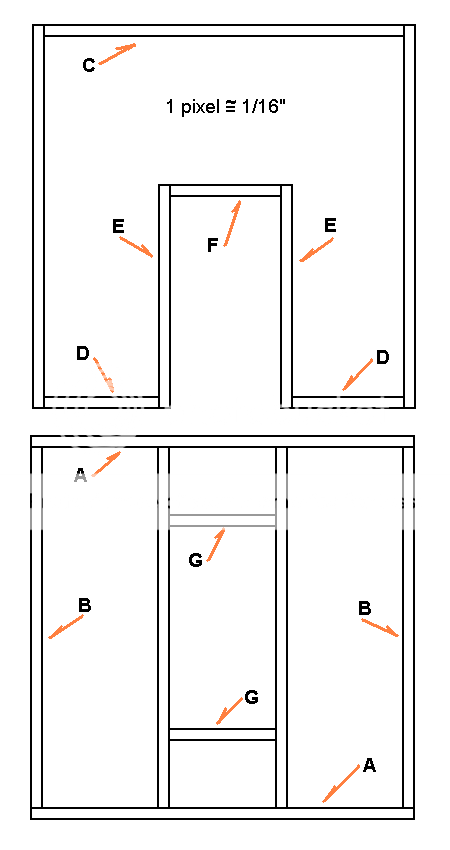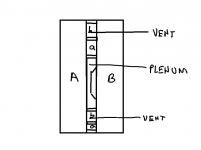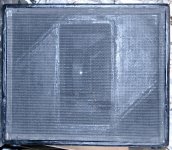I've been reading several of the PPSL threads. Each has good info, but the bits I'm looking for are so scattered that I cant get a clear picture of this cabinet.
Here's what I'm getting at: How does one come up with the volume of a PPSL box like this:
http://www.diyaudio.com/forums/subwoofers/245114-finally-finished-dual-18-ppsl.html
I understand the design is basically 2 speakers sharing one single vented box, then rearranged to a particular shape to keep the drivers very near each other. The PPSL box volumes seem smaller compared to sim recommendations for 2 speakers.
For example, two Eminence Kappa 18 might fit nicely in a 20 ft^3 enclosure tuned to 35Hz. What changes when considering a PPSL box design?
CHAD
Here's what I'm getting at: How does one come up with the volume of a PPSL box like this:
http://www.diyaudio.com/forums/subwoofers/245114-finally-finished-dual-18-ppsl.html
I understand the design is basically 2 speakers sharing one single vented box, then rearranged to a particular shape to keep the drivers very near each other. The PPSL box volumes seem smaller compared to sim recommendations for 2 speakers.
For example, two Eminence Kappa 18 might fit nicely in a 20 ft^3 enclosure tuned to 35Hz. What changes when considering a PPSL box design?
CHAD
Chad,The PPSL box volumes seem smaller compared to sim recommendations for 2 speakers.
For example, two Eminence Kappa 18 might fit nicely in a 20 ft^3 enclosure tuned to 35Hz. What changes when considering a PPSL box design?
The only change to consider is the volume of the plenum reduces the box volume, so generally should be made as small as practical.
Most sim recommendations are for a "flat" alignment, smaller boxes when tuned low have rolled off LF by comparison, but can be EQd flat.
Art
Another consideration is that the slot cavity will have its own resonance that varies depending on its volume and dimensions. Typically this shows up above the passband of the subwoofer (300+hz) so it's not of much concern, but it's something that might be worthwhile to know is there.
I've been reading several of the PPSL threads. Each has good info, but the bits I'm looking for are so scattered that I cant get a clear picture of this cabinet.
Here's what I'm getting at: How does one come up with the volume of a PPSL box like this:
http://www.diyaudio.com/forums/subwoofers/245114-finally-finished-dual-18-ppsl.html
I'm curious as to why people would choose to build a PPSL with the drivers mounted horizontally, when vertically seems to be the more obvious choice (vertical mounting = no cone sag, both drivers are the same distance from the vent, and there's no chance of the plenum acting as a restriction to part of the volume of the box). You can even get a bit creative with the design, e.g. design the plenum so both the front and back are open, or design the box so the vents are in line with the plenum (see horrible not-to-scale sketch attached)
Attachments
Brian,I'm curious as to why people would choose to build a PPSL with the drivers mounted horizontally, when vertically seems to be the more obvious choice (vertical mounting = no cone sag, both drivers are the same distance from the vent, and there's no chance of the plenum acting as a restriction to part of the volume of the box).
Most people are simply copying DJK's PPSL design, and don't think of slow acting problems like cone sag. That said, there is no reason that the usual design can't be run (or stored) with the cones vertical. Distance to the ports and the plenum restriction are a non-issue if built like DJK's.
A vertical alignment is advantageous from a gravity standpoint, and also allows for better heat transfer.
In my "Shoehorn" 2x15" PPSL the enclosed magnet structure vent heat rises out of the upper port, the lower port allowing for a "chimney effect" heat rise with fresh air entering through the lower port.
Art
Attachments
Last edited:
http://i56.photobucket.com/albums/g196/dkleitsch/CoePA-2009.jpg
Preferred method for stacking.
http://i56.photobucket.com/albums/g196/dkleitsch/COE08-3.jpg
My friend Steve stacks his this way, but stores and transports the correct way.
http://i959.photobucket.com/albums/ae76/fullrangebates/pudhpullsubquad12_zpsb771020a.jpg
My friend Norman's sub with the slot rotated 90° so the port is at the floor (cat is optional).
http://i959.photobucket.com/albums/ae76/fullrangebates/DSC04832_zps02177ea6.jpg
Another one that is not the best stack job.

The first proof-of-concept dual 12 PPSL, circa 1985. Ports were above and below the woofer plenum. This was a high output (100dB) 4th order 40hz design 2' cube with inexpensive Eminence woofers, one 4x8 sheet (and maybe a small scrap needed). A high school student in Indiana built this and used with some 100hz 98dB 10" + KSN1025 tops for a DJ system.
I also built a couple different dual 18 with this same port arrangement, one set tuned to 38hz for live sound, the other tuned to 27hz for dance music. After losing a couple of sets of 18's in the 27hz box (can you say octave divider?), they were retuned to 40hz and then slammed with a Crest 7001.
Preferred method for stacking.
http://i56.photobucket.com/albums/g196/dkleitsch/COE08-3.jpg
My friend Steve stacks his this way, but stores and transports the correct way.
http://i959.photobucket.com/albums/ae76/fullrangebates/pudhpullsubquad12_zpsb771020a.jpg
My friend Norman's sub with the slot rotated 90° so the port is at the floor (cat is optional).
http://i959.photobucket.com/albums/ae76/fullrangebates/DSC04832_zps02177ea6.jpg
Another one that is not the best stack job.

The first proof-of-concept dual 12 PPSL, circa 1985. Ports were above and below the woofer plenum. This was a high output (100dB) 4th order 40hz design 2' cube with inexpensive Eminence woofers, one 4x8 sheet (and maybe a small scrap needed). A high school student in Indiana built this and used with some 100hz 98dB 10" + KSN1025 tops for a DJ system.
I also built a couple different dual 18 with this same port arrangement, one set tuned to 38hz for live sound, the other tuned to 27hz for dance music. After losing a couple of sets of 18's in the 27hz box (can you say octave divider?), they were retuned to 40hz and then slammed with a Crest 7001.
Last edited:
"How does one come up with the volume of a PPSL box like this:"
Low Qts
Posted by djk (M) on September 29, 2007 at 03:03:05
In Reply to: RE: JBL Scoop posted by Hornlover on September 28, 2007 at 08:33:11:
The optimum Qts for minimum box size and maximum bass extension is 0.312
Qts in the range of 0.25~0.40 is OK.
If much higher than 0.40 a sealed box is indicated, if much lower than 0.25 a horn is indicated.
***********************************************************************
A little known fact is you can 'burn' Qts if it is lower than what you need(no more than 20%).Another tactic would be to use the low Qts to reduce the box size and raise the Fb to keep it flat.
The optimum Qts for an equalized 6th order Butterworth design(not to be confused with a bandpass design)is .312 .The formula for box size is Qts*Qts*4.1*Vas=Vb.The formula for Fb is (Fs/Qts)*.312 .For a Qts of .312 the Faux(eq frequency)=Fb with a Q of 2 .
***********************************************************************
Box size is roughly proportional to the square of the Qts, so the lower the Q the smaller the box. Also the lower the Q, the higher the efficiency. Bass rolls off though if the Q is too low, the magnet can be too big for its own good.
For a vented box, the optimum Qts is 0.312
0.312 gives the best bass extension, minimum box size, and highest efficiency.
Posted by djk ( M ) on July 25, 2005 at 00:55:59
A 2 cu ft 2nd order sealed box with an F3 of 30hz can only be 0.18% efficient (84.55dB).
A 2 cu ft 4th order vented box with an F3 of 30hz can only be 0.36% efficient (87.56dB).
A 2 cu ft 6th order vented box with an F3 of 30hz can only be 0.90% efficient (91.54dB).
The correct box size for a Qts=0.312 woofer for the 6th order vented design is Vas*4.1, Fb=Fs=Faux, Q=2 for Faux.
Without the Q=2 filter the box is an SBB4, with the best transient response of all the standard vented alignments, with the filter it is a B6(maximally flat).
The link describes a couple of DIY 6th order sub designs from JBL.
1983 JBL SUBWOFFER DESIGN
*****************************************************************
The Qts of the old JBL drivers is way to low to be optimum for bass reflex.
Will they work?
Sure.
But they will sound more balanced in a BLH.
Low Qts
Posted by djk (M) on September 29, 2007 at 03:03:05
In Reply to: RE: JBL Scoop posted by Hornlover on September 28, 2007 at 08:33:11:
The optimum Qts for minimum box size and maximum bass extension is 0.312
Qts in the range of 0.25~0.40 is OK.
If much higher than 0.40 a sealed box is indicated, if much lower than 0.25 a horn is indicated.
***********************************************************************
A little known fact is you can 'burn' Qts if it is lower than what you need(no more than 20%).Another tactic would be to use the low Qts to reduce the box size and raise the Fb to keep it flat.
The optimum Qts for an equalized 6th order Butterworth design(not to be confused with a bandpass design)is .312 .The formula for box size is Qts*Qts*4.1*Vas=Vb.The formula for Fb is (Fs/Qts)*.312 .For a Qts of .312 the Faux(eq frequency)=Fb with a Q of 2 .
***********************************************************************
Box size is roughly proportional to the square of the Qts, so the lower the Q the smaller the box. Also the lower the Q, the higher the efficiency. Bass rolls off though if the Q is too low, the magnet can be too big for its own good.
For a vented box, the optimum Qts is 0.312
0.312 gives the best bass extension, minimum box size, and highest efficiency.
Posted by djk ( M ) on July 25, 2005 at 00:55:59
A 2 cu ft 2nd order sealed box with an F3 of 30hz can only be 0.18% efficient (84.55dB).
A 2 cu ft 4th order vented box with an F3 of 30hz can only be 0.36% efficient (87.56dB).
A 2 cu ft 6th order vented box with an F3 of 30hz can only be 0.90% efficient (91.54dB).
The correct box size for a Qts=0.312 woofer for the 6th order vented design is Vas*4.1, Fb=Fs=Faux, Q=2 for Faux.
Without the Q=2 filter the box is an SBB4, with the best transient response of all the standard vented alignments, with the filter it is a B6(maximally flat).
The link describes a couple of DIY 6th order sub designs from JBL.
1983 JBL SUBWOFFER DESIGN
*****************************************************************
The Qts of the old JBL drivers is way to low to be optimum for bass reflex.
Will they work?
Sure.
But they will sound more balanced in a BLH.
- Status
- This old topic is closed. If you want to reopen this topic, contact a moderator using the "Report Post" button.
- Home
- Loudspeakers
- Subwoofers
- PPSL Basic Question

